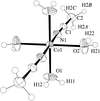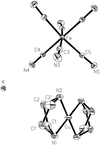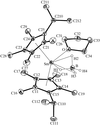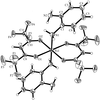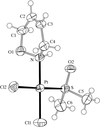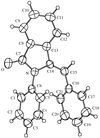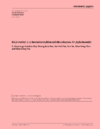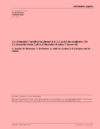issue contents
January 2000 issue

Cover illustration: The layer structure of bis(tetrahydrothiophene-S)gold(I) benzene-1,2-disulfonimidate, p. 56.
editorial
Free 

inorganic compounds
Download citation


Download citation


The crystal structure of Rb4Zr3Te16 consists of infinite one-dimensional chains of [Zr3Te16]n4n− separated from each other by Rb+ cations. Within the chain, each Zr atom is surrounded by eight Te atoms to give a distorted bicapped trigonal prism polyhedron.
Download citation


Download citation


The structure of K2[Al2Sb2O7] consists of [Al2Sb2O7]2− layers containing Al3+ in a nearly regular tetrahedral and Sb3+ in a Ψ-tetrahedral environment of O ligands.
metal-organic compounds
Download citation


Download citation


Download citation


Download citation


Download citation


Download citation


Download citation


Download citation


Download citation


Download citation


Download citation


Download citation


Download citation


Download citation


Download citation


Download citation


Download citation


Download citation


Download citation


Download citation


Download citation


Download citation


Download citation


Download citation


Download citation


Download citation


Download citation


Download citation


Download citation


Download citation


Download citation


Download citation


Download citation


Download citation


Download citation


Download citation


Download citation


Download citation


Download citation


Download citation


Download citation


Download citation


Download citation


Download citation


Download citation


Download citation


Download citation


Download citation


organic compounds
Download citation


Download citation


Download citation


Download citation


Download citation


Download citation


Download citation


Download citation


Download citation


Download citation


Download citation


Download citation


Download citation


Download citation


Download citation


Download citation


Download citation


Download citation


Download citation


Download citation


Download citation


Download citation


Download citation


Download citation


Download citation


Download citation


Download citation


Download citation


Download citation


Download citation


Download citation


Download citation


Download citation


Download citation


Download citation


Download citation


Download citation


Download citation


Download citation


Download citation


Download citation


Download citation


Download citation


Download citation


Download citation


Download citation


international union of crystallography
Free 

electronic papers (inorganic compounds)
Download citation


Download citation


BiSeI crystals were obtained by a chemical-transport reaction and were shown to be of the centrosymmetric SbSI structure type.
electronic papers (metal-organic compounds)
Download citation


Download citation


The crystal and molecular structures of (PhCMe2CH2)4Sn at 150 K are essentially the same as those at 293 K but with shorter cell dimensions and smaller s.u. values on the cell and atomic parameters.
Download citation


Download citation


In [Mg(H2O)6](C7H8N5O4)2·2H2O, the Mg ion lies on an inversion centre with Mg—O distances in the range 2.0437 (10)–2.0952 (10) Å. The [Mg(H2O)6]2+ cations, the anions and the water molecules are linked by an extensive hydrogen-bond network.
Download citation


Download citation


The Schiff base ligand in the title complex is deprotonated with respect to its tautomeric thiol form and is coordinated to the PtII atom via the mercapto-S and β-N atoms. The PtII coordination is square planar. The phenyl ring of the ligand is twisted out of the coordination plane by 31.8 (2)° due to the steric effect of the Br atom.
Download citation


Download citation


The title compound is isomorphous with the La and Lu analogues having three bidentate nitrate and two bipyridyl ligands, giving the metal atom a ten-coordinate bicapped dodecahedral environment. The average Nd—N and Nd—O bond lengths (2.596 and 2.549 Å, respectively) are shorter than the corresponding bonds of the La analogue reflecting the smaller ionic radius of neodymium. There is evidence that the non-coordinating O atom of the nitrate group lying formally on a crystallographic twofold axis is disordered on either side of the axis.
Download citation


Download citation


In the title complex, the Mn atom lies on an inversion centre and the Cl atom of the perchlorate anion is on a twofold axis. In the cation, the Mn atom has distorted octahedral coordination with distances Mn—N 2.206 (3) Å, Mn—O(phenolato) 1.871 (2) Å and Mn—O(propanolato) 2.300 (2) Å.
Download citation


Download citation


Half-normal probability plots and r.m.s. calculations were used to compare two structural solutions of trans-[PtCl2(PPh3)2] with each other, as well as with the isomorphous palladium compound. The geometrical parameters, including Pt—P = 2.3163 (11) Å and Pt—Cl = 2.2997 (11) Å, are compared with those of related phosphine and arsine complexes.
Download citation


Download citation


The structures of three four-coordinate nickel(II) complexes of the form [Ni(sacsac)(L)]PF6 [sacsac is the pentane-2,4-dithione anion; L = Ph2P(CH2)nPPh2, where n = 1, 2 or 3] have been determined. All have a distorted square-planar arrangement about the Ni atom, with angles varying with the length of the hydrocarbon chain.
electronic papers (organic compounds)
Download citation


Download citation


The packing of the title compound, which crystallizes in planes parallel to (100), is stabilized by a bifurcated N—H⋯Br hydrogen bond and short C—H⋯Br contacts. The crystal structure is not isostructural with that of 4-dimethylaminopyridinium chloride.
Download citation


Download citation


The conformation of the title molecule (BQSDA), a new chiral sulfonamide ligand, is determined by a bifurcated N—H⋯N hydrogen-bond system. The acetone molecule of solvation is linked to the BQSDA molecule by an N—H⋯O hydrogen bond.
Download citation


Download citation


Hexabenzylbenzene is located on a point of  symmetry and has an ababab conformation (a and b denoting side-chain units projecting, respectively, above and below the plane of the aromatic core). The molecule has symmetry quite close to C
symmetry and has an ababab conformation (a and b denoting side-chain units projecting, respectively, above and below the plane of the aromatic core). The molecule has symmetry quite close to C (S6).
(S6).
Download citation


Download citation


The structure of taurine (2-aminoethanesulfonic acid) has been redetermined at 150 K and is compared with the structures of glycine and β-alanine which, like taurine, are enzymatically conjugated with bile acids.
Download citation


Download citation


Condensation of mesitonitrile oxide with 1,7-dimethyl-5-phenyl-2,3-dihydro-1H-1,4-diazepine leads to two cycloadducts. The structure of one of these has been established crystallographically, identifying it as a spiro-tricyclic compound.
Download citation


Download citation


The title compound is a product of the reaction of 2-nitrobenzenesulfonyl chloride with N,N-diisopropylethylamine (DIEA) and hydroxylamine hydrochloride. The central N atom is essentially planar, lying 0.071 (2) Å out of the plane defined by the three S atoms.
Download citation


Download citation


The condensation reaction of 2-amino-5-tert-butyloxymethyl-2-oxazoline with ethyl cyano(ethoxymethylene)acetate led to the title cycloadduct. The structure indicates delocalization in the pyrimidine ring.
Download citation


Download citation


The title molecule has a trans stereochemistry for the methyl and isopropyl groups in α positions with respect to the N atom.
Download citation


Download citation


The presence of traces of water in the reaction of pyridinedithiomonometaphosphoryl chloride with 4-(trimethylsilyl)morpholine resulted in the title compound.
Download citation


Download citation


The title new cylindrical macrobicyclic imidazolium cyclophane has a mirror plane passing through the three imidazole rings. The Br− anions are associated with two water molecules by hydrogen bonding.


 journal menu
journal menu
















